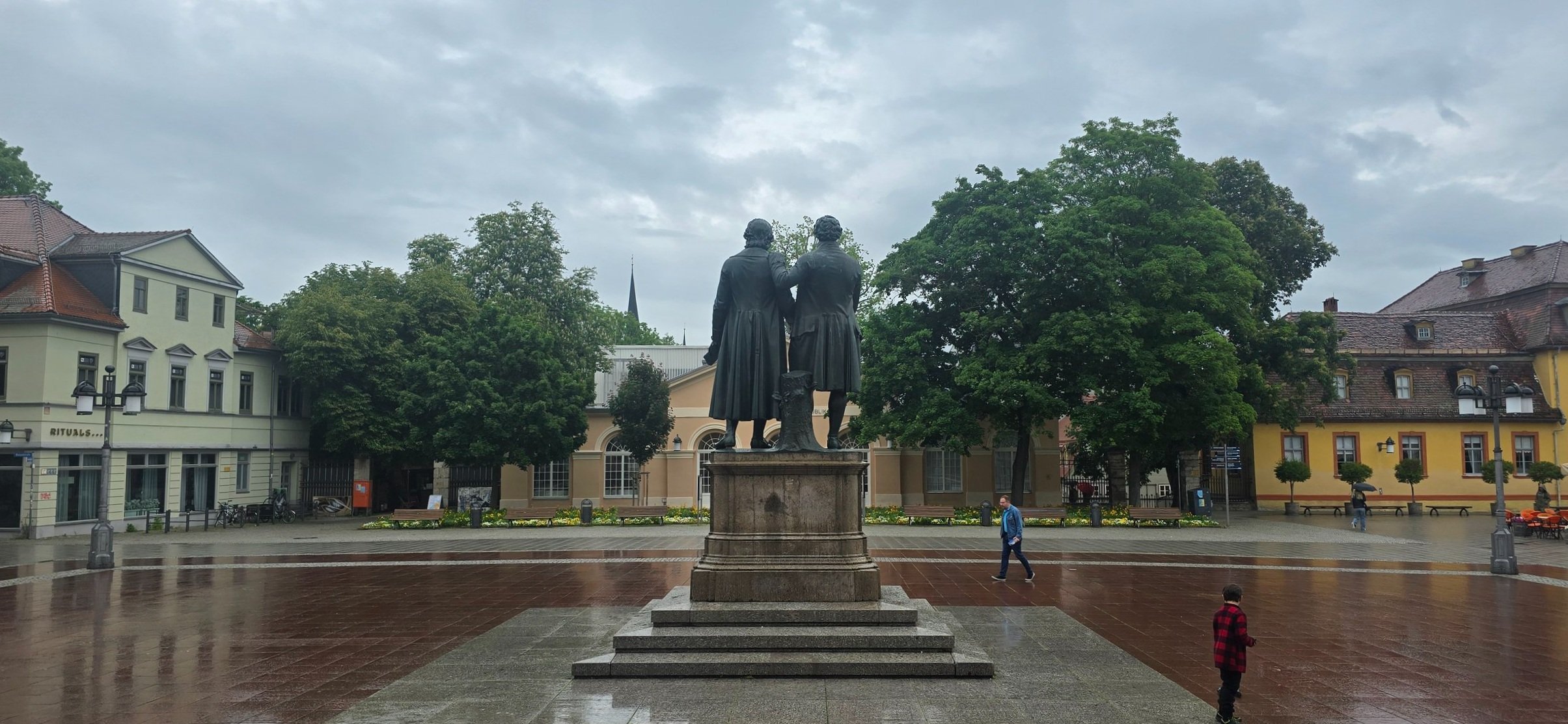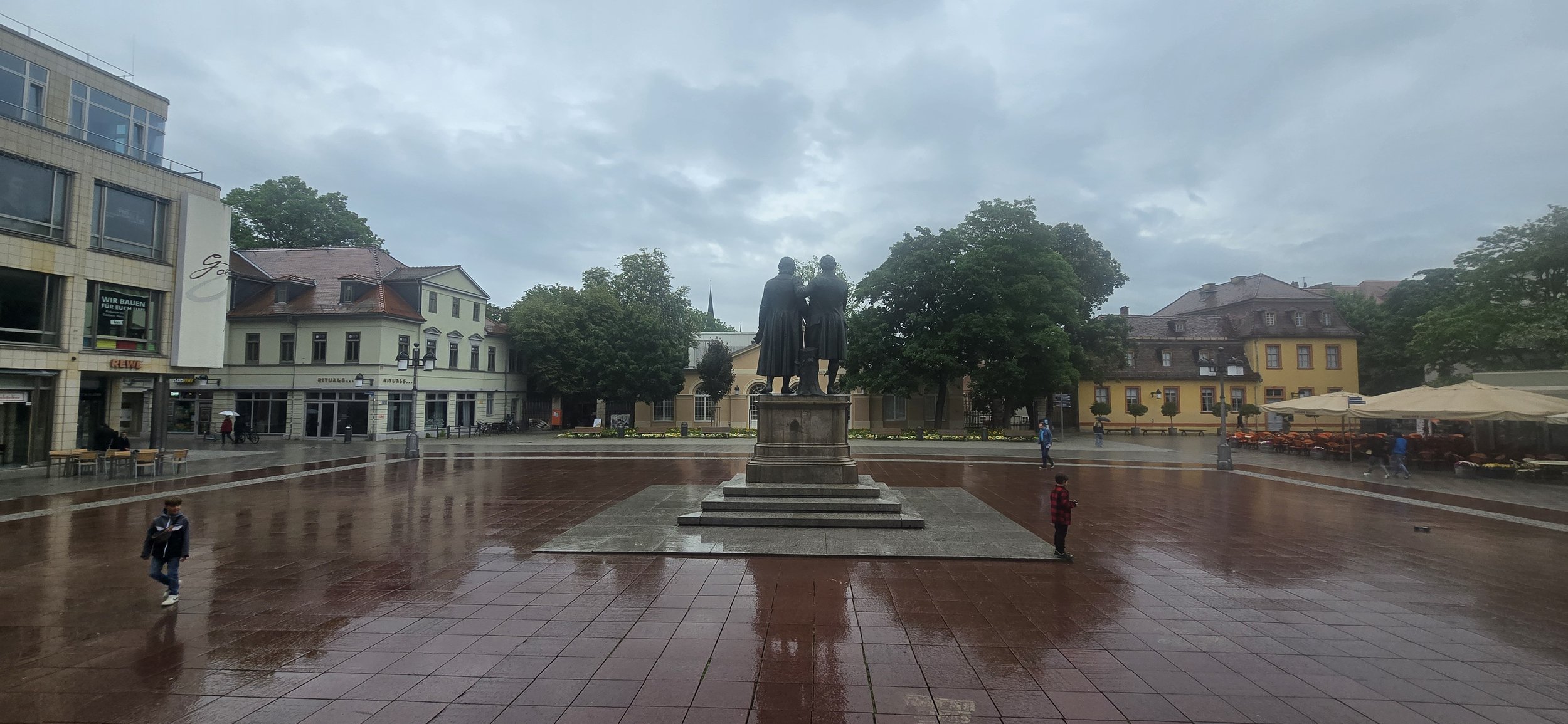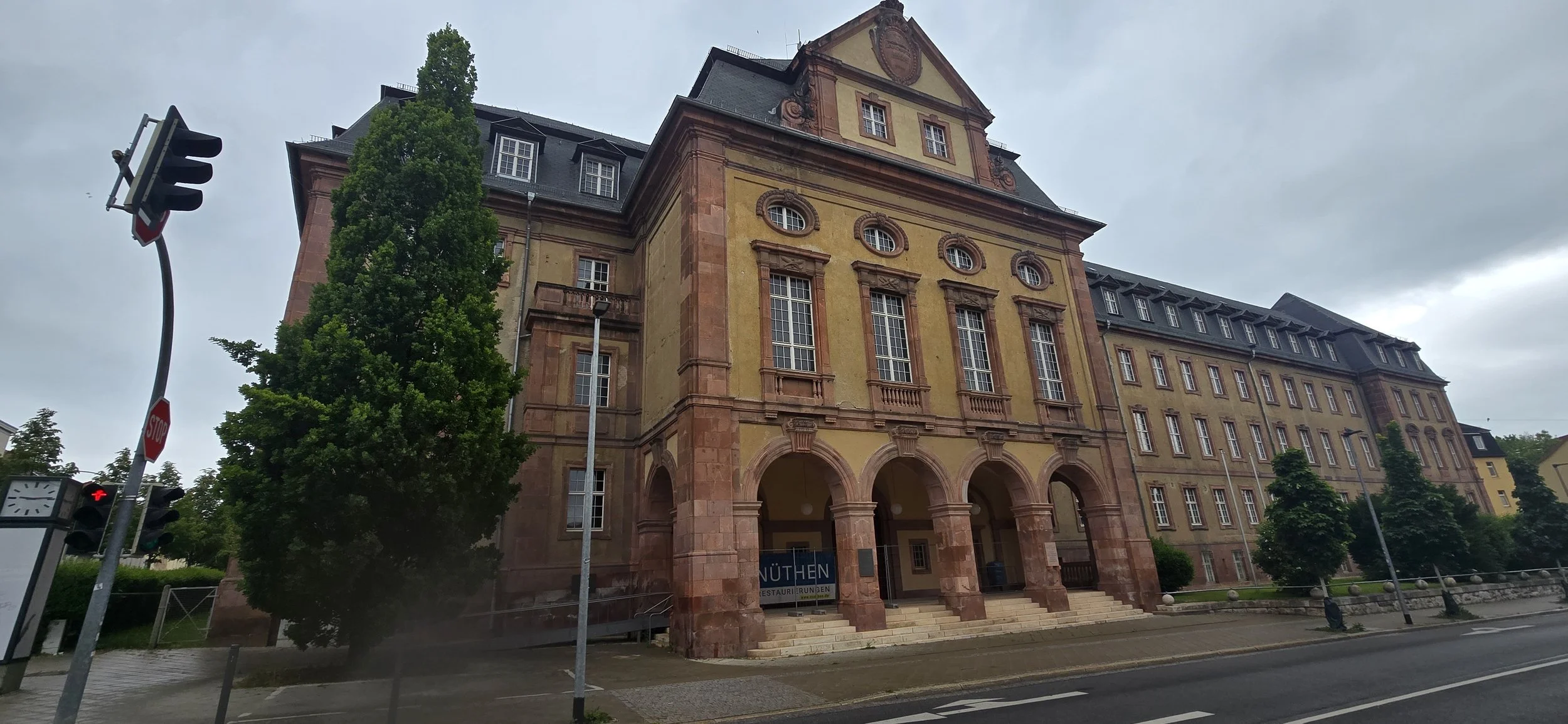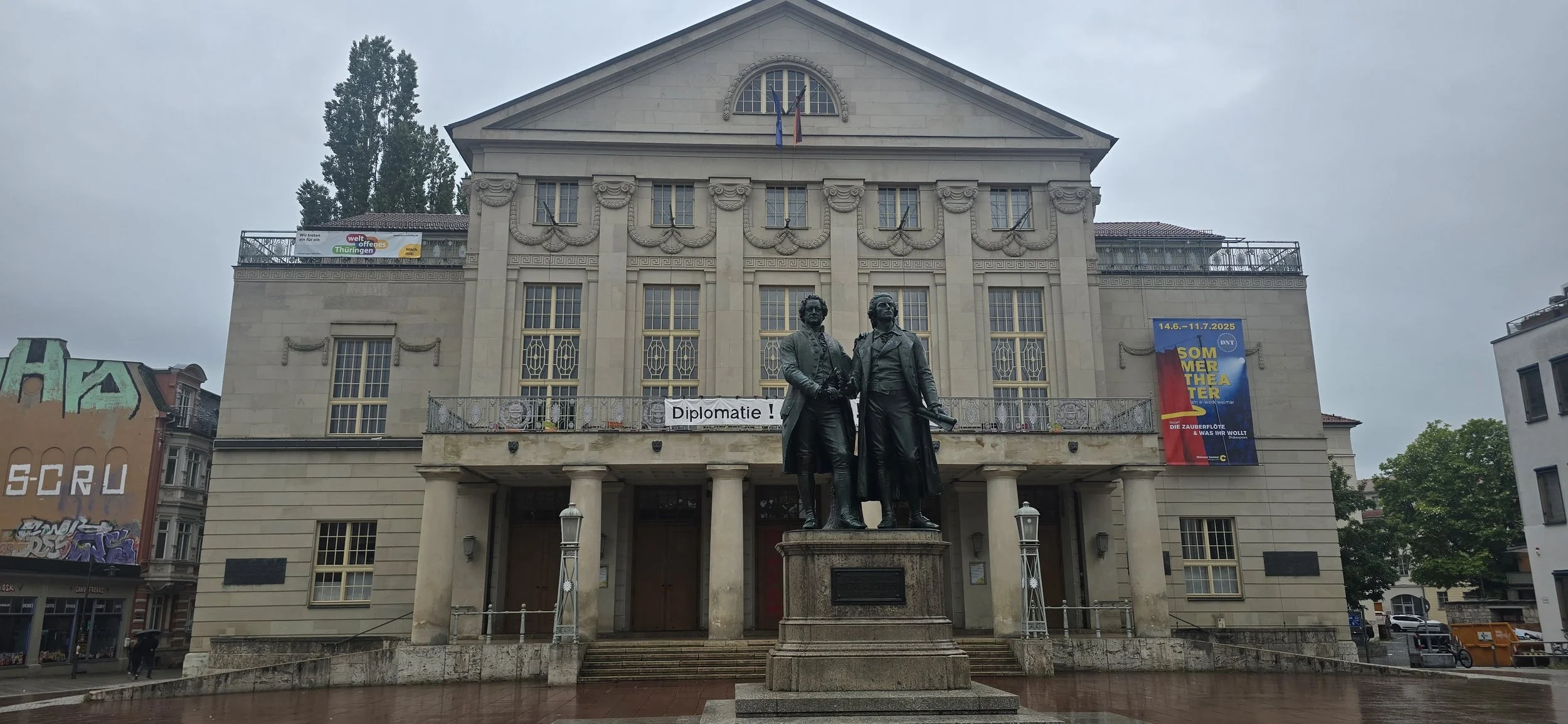
Weimar
Almost 10,000 Jewish men were deported to the Buchenwald concentration camp in the days after the November pogrom of 1938. They came from Breslau, Dresden, Frankfurt, Bielefeld, Aachen and all over Thuringia, among others. They were transported by the Reichsbahn to Weimar Central Station, where they were driven through the tunnel passage by SS men and auxiliary police and beaten up.
Rosa Grill-Freimann was born on March 3, 1882 in Zölkiew/Galicia. On a boat trip, the kindergarten teacher met Arthur Schmidt, who came from a long-established Weimar family and worked as a chef on the ship. The young couple initially ran a hotel in Alexandria, Egypt, but moved back to Germany with their children during the First World War. After the war, Rosa and Arthur Schmidt took over the Hotel Hohenzollern at Weimar Bahnhof, which also included a beer pub. It was located on the ground floor in the right half of the building. In June 1944, a penalty order was issued against Arthur Schmidt because he had not entered his wife as a Jew in the household list. Although she was Protestant, she was considered a "full Jew" and her four children were "half-breeds of the first degree". A few months later, Rosa Schmidt was arrested and deported to the Auschwitz extermination camp, where she was murdered on November 28, 1944. In December, shortly before his own death, her husband wrote a letter to the Auschwitz camp commander asking for her remains to be sent. It is unclear whether he received an urn. Rosa Schmidt's name can be found on a small family gravestone in Weimar's main cemetery.
On January 1, 1934, the Gestapo headquarters for Thuringia was founded in Weimar. It was housed in the Weimar police headquarters, a representative building of the early Wilhelminian period. The year of construction of the building, 1884, can be found on the corner of the building and Meyerstraße. The tasks of the Gestapo as a political police included in particular the monitoring and combating of "subversive activities". However, the participation of the population in this work was already too active for the Gestapo in May 1934. Countless denunciations had led to work overload. She therefore considered it necessary to combat the "unworthy appearance of denunciation of the German people". Reports of allegedly "anti-state statements" are mostly personal disputes, especially among neighbors. The Gestapo wrote up-to-date situation reports on the political mood of the population and reported to the Reich Ministry of the Interior the arrests of political opponents carried out in Thuringia. In the basement of the police headquarters there were some cells that were used as a transit station to the Buchenwald concentration camp until the end of the war. As the Gestapo grew continuously, it moved into the Marstall building in 1936. When the Gauforum was completed, it should have had its final seat there.
The building for the district court, district court, public prosecutor's office and court prison was built during the First World War. Until 1945, its courtyard was the place of execution for Thuringia. Since 1933, almost 200 death sentences have been carried out here. On January 5, 1945, the execution of eight men and one woman took place, mostly members of a resistance group active in the Suhl area. Among them was Adolf Wicklein from Sonneberg, who had listened to news from Allied radio stations and maintained contacts with Soviet prisoners of war. The Weimar Special Court often sentenced those accused under "special war criminal law" to death for petty offenses. The accusations ranged from "insulting the Führer", "malice", "prohibited contact with prisoners of war or forced labourers" to "subversion of the armed forces". Since 1943, Wehrmacht deserters were also convicted and judged here. The medical faculty of the University of Jena picked up the bodies from Weimar to use them for scientific purposes. Meticulous care was taken to ensure that the traces of the nightly executions and the "Richtgeräte", a guillotine from the 19th century, were not visible in the public building. However, the concrete courtyard corner and the drainage grid were clearly visible from all windows facing the inner courtyard. Since 1987, a memorial plaque has commemorated the almost 200 victims of Nazi justice. After the end of the war, the building housed the Soviet Military Tribunal. Five victims of Stalinism sentenced to death in Weimar between 1950 and 1953 are commemorated by two other memorial plaques.
For the prestige project of the National Socialists in Weimar, the Gauforum, the northern part of the Jakobsvorstadt, a total of 139 houses, had to be demolished and the small river Asbach diverted. Such gaudors, in which the central administrations of a NSDAP gau were to be combined, were planned in all district capitals in Germany, but were only largely implemented in Weimar. On May 1, 1937, Rudolf Hess laid the foundation stone of the "Hall of the People's Community" and renamed the square "Platz Adolf Hitlers". 40,000 people took part in the carefully staged mass event. The massive complex clearly shows the NSDAP's claim to leadership, the town houses of the city of Weimar were supposed to appear small next to it. Hitler personally supplemented the design with the "Hall of the People's Community" with 20,000 standing places and a bell tower, which was to become the tallest building in Weimar. Fritz Sauckel celebrated his 45th birthday in it in 1939. By 1943, all buildings with the exception of the hall had been completed, and prisoners from the Buchenwald concentration camp were also used in the construction work.
After the completion of the Gauforum, the move of Fritz Sauckel's Reich Governor's Office from the State Museum to the southern wing of the Gauforum, the "Reich Governor's Office and Gau Leadership", was planned. An oversized study was planned for Fritz Sauckel on the first floor of the building, which was additionally highlighted by a balcony and the entrance portal. The plans for the structural redesign of Weimar also related to the immediate vicinity of the Gauforum. In the völkisch Heimatschutz style, the new street layout, provisionally named "X Street", was laid out, today's Ferdinand Freiligrath-Straße. The resulting apartments also served as a replacement for the approximately 1,650 residents of Jakobsvorstadt who were affected by the demolition of the district. The character of the street is particularly visible at house no. 21, the Siechenbräu inn, which has existed since August 1939. The street view consists of columns based on the Romanesque model, decorated with old Germanic-looking decorations of the column capitals.
The Court Theatre, founded in 1791 under Goethe's direction, was given the name Deutsches Nationaltheater (DNT) in 1919 when the National Assembly met here and adopted the constitution of the Weimar Republic. A memorial plaque designed by Walter Gropius commemorating the adoption of Germany's first democratic constitution was removed by SA members in March 1933. A replica of the plaque can be seen today to the left of the entrance. The National Socialists tried to use the DNT, the place of Weimar Classicism, for their goals and to overwrite its republican past. In 1926, the NSDAP held its first Nazi party rally here in the presence of Hitler after the refoundation. Many other party events followed. In particular, the tenth anniversary of the Nazi Party Rally in 1936 was celebrated with lively participation of the population. Crowds gathered in front of the theatre to cheer their "Führer".

During the Nazi era, Hitler's confidant Hans Severus Ziegler acted as general director. The advocate of the "blood and soil" ideology banned plays by Jewish and politically unpopular authors from the repertoire. He also vehemently campaigned for the dismissal of "non-Aryan" actors and musicians. The SS guards of the nearby Buchenwald concentration camp, on the other hand, were courted as an audience. With the C7 rental series, the best seats were reserved for them. The DNT also made several guest appearances in the SS casino in Buchenwald. Hitler, who wanted to develop the Weimar National Theatre into a leading stage of the German Reich, not only supported it financially, but also attended numerous opera and operetta performances. The central box in the first tier was specially redesigned for him and decorated with a swastika ceiling hanging over the parapet. At the beginning of the 1930s, the ensemble included the actress Emmy Sonnemann, who later became Hermann Göring's wife. In September 1944, the theatre had to close and was used as an armaments factory for the Siemens & Halske company. During the air raid on 9 February 1945, the building burned down.
In 1936, the control center of the Secret State Police (Gestapo) moved from the police headquarters in what was then Sophienstraße to the former grand ducal stables. The temporary functional buildings erected in the courtyard of the building were only intended to last until the planned move to the Gauforum. In addition to the administrative barracks with a double-walled, insulated interrogation room, there was a makeshift prison with twelve cells in the former coach house of the Marstall, which was converted by concentration camp prisoners from Buchenwald. Spying, house searches, arrests, torture and coerced testimony were all part of the authorities' practice. By imposing "protective custody", it was able to have suspects sent to a concentration camp for an indefinite period of time without evidence, charge or judgment. From May 1942, the Gestapo supervised and directed the deportation of all Jewish residents of Weimar to extermination camps, with the Reithalle serving as a collection point before the transfer to the goods station. After the end of the war, political prisoners of the Soviet occupation authorities and the Weimar district court were also imprisoned in the stables. From July 1951, the rooms were used to store the files of the State Main Archive, now the Thuringia State Archive. When a deep storage facility had to be created for the archive, the two buildings in the inner courtyard were demolished and publicly shredded in 1997 as part of Horst Hoheisel and Andreas Knitz's art project "Zermahlene Geschichte" (Crushed History). Their floor plans are now visible as a walk-in installation. The Gestapo cells in the main building now house a permanent exhibition on the history of the site.
Due to alleged dilapidation, the Hotel Elephant was demolished down to the foundation walls in 1937 and replaced by a new building. The Elephant was to become the most modern hotel of its time; the commission for this was awarded to Hermann Giesler, who, as the architect of the Gauforum, was in Adolf Hitler's special favour. The use of marble and German precious woods underlined its representative character. The folksy restaurant Elephanten-Keller in the vault of the house was designed in the style of old Germanic forms. The balcony on the market side was also intended as a speaker's platform, structurally highlighted by flagpoles and the relief of the imperial eagle. Facing the garden, a suite was designed on the 1st floor according to Adolf Hitler's individual wishes, which was not used by other hotel guests. The topping-out ceremony was celebrated on Hitler's birthday in 1938, the house was ready for occupancy on the Gautag in November and Hitler was his first guest. During visits to Weimar by the "Führer", the market was used as a parade ground. The people of Weimar gathered and chanted: "Dear Führer, please, please, direct your steps to the balcony."
Federal elections were held in Germany on A Ballot box from 19 January 1919 used to elect a national constituent assembly that would write a new constitution for Germany following the collapse of the German Empire at the end of World War I. The election, which took place amid the sometimes violent political upheaval of the German revolution, used a form of proportional representation, lowered the voting age to 20 and allowed women to vote for the first time.
he Court Theatre, founded in 1791 under Goethe's direction, was given the name Deutsches Nationaltheater (DNT) in 1919 when the National Assembly met here and adopted the constitution of the Weimar Republic. A memorial plaque designed by Walter Gropius commemorating the adoption of Germany's first democratic constitution was removed by SA members in March 1933. A replica of the plaque can be seen today to the left of the entrance.










